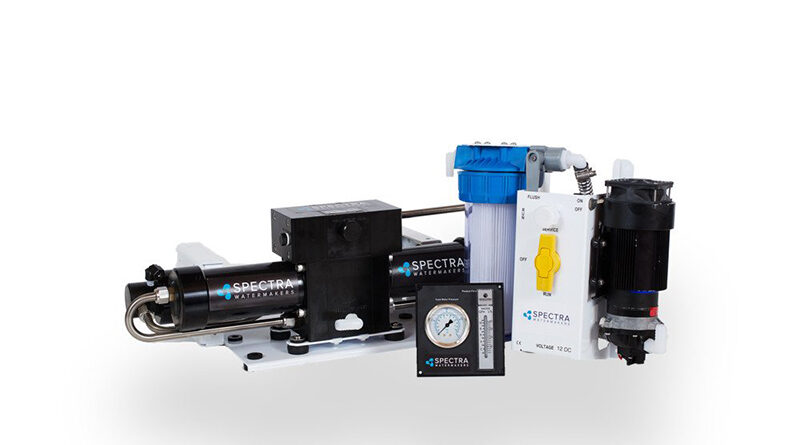Enhance Your Boating Life with a Watermaker
If there is one thing setting a yacht apart from all others in a cruiser anchorage, it is the vessel’s capacity to draw saltwater directly from the ocean and transform it into fresh water. That one key ability, drawing its power from multiple possible sources, ensures long-term independence from the hassle of filling and carrying jerry cans with water, sometimes of dubious quality, at every anchorage on an ocean cruise.
Choosing the Right Watermaker
Reverse-osmosis watermakers are generally categorized by the type of power they use, DC, AC or mechanical, the last of which is provided directly by the propulsion engine. On a typical cruising vessel of anywhere from 35 to 60 feet LOA, a 12- or 24-volt DC watermaker system is probably the best choice. This allows a wider range of installation options, since the unit does not need to be close to the main power plant.
Sea Recovery, a subsidiary of Parker Hannifin, offers its smallest desalinator, the Aqua Matic 450-1, producing 450 gallons per day (GPD) for mid-size to larger yachts. The Aqua Matic may be run on either DC or AC current. The Sea Recovery range of desalinators extends all the way up to very large systems for passenger ships.
PowerSurvivor, a division of Katadyn in Switzerland, produces a wide range of watermakers, beginning with their humble, hand-powered Katadyn Survivor 06, which is small and light enough to fit in a cruising kayak. The Survivor 06 is Coast Guard-approved as an emergency survival device. This is a good thing to carry in your ditch bag, regardless of the type of permanent-mount watermaker you install.
The entry-level, permanently installed PowerSurvivor system is the Spectra Ventura 150, which runs on either 12 volts or 24 volts DC. This unit produces 6.3 gallons per hour (GPH) (150 GPD), more than enough for the average cruising boat. Weighing 60 pounds and running on either 12 or 24 volts DC at 4.5 amps, this unit is relatively easy to install and maintain. Since the unit consists of several main components, it offers a bit of flexibility in installation.
PowerSurvivor’s cruising selection of watermakers ranges from the Spectra Ventura 150D (30 GPH) to the Spectra Newport series for large power and sailing craft. The Daily Cruiser can be configured to be engine driven or powered by an AC source.
At the top end of the line, the Spectra Newport 1000C produces 41 GPH (1,000 GPD) and runs on 24 volts DC or 120/240 volts AC. Though lower temperatures are known to inhibit the reverse osmosis process, PowerSurvivor boasts their watermakers are “designed to operate efficiently from the Arctic to the Equator.”
The Swedish company Dometic, known for its wide range of recreational and marine appliances, offers a unique selection of high-end desalinators through its Sea Xchange product line. What sets these watermakers apart from the competition is a digital, fully automatic fresh water management system you control by way of a color touchscreen. Each model offers NMEA 2000 connectivity, allowing you to control the unit from your chartplotter.
If you have a mid-size or larger vessel, look into the Dometic Sea Xchange models, which are designed for convenience and ease of use. For a completely self-tending unit, consider the SX watermaker series, available in four sizes, from 600 to 2200 GPD.
FCI Watermakers of West Valley City, Utah, manufactures 15 models of marine watermakers, from the small, economical 200 GPD Aqualite to much larger designs intended for large ships and institutions.
A good choice for larger yachts is FCI’s 200 or 250, both of which deliver 1800 GPD, more than enough for the demands of most yachts. The Framed version houses the entire unit inside a metal box, while the Modular version leaves major components exposed for easy access and servicing. Offered as “traditional” watermakers, both models have analog pressure and flow meters and a “fully automated programmable fresh water flush system.”
If there is a manufacturer out there listening to the pleas of humble sailors for a compact, modestly priced, easy-to-use desalinator, it is Schenker Dissilatori of Naples, Italy. Three design levels – Zen, Smart, and Modular – comprise Schenker’s line-up, each one offering a range of units with several levels of output.
Zen, the entry-level desalinator series, covers the fresh water needs of most cruising craft, offering outputs of 8 to 40 GPH, depending on the model. The Zen 30, which produces up to 190 GPD, is sufficient for sailing vessels of 30 to 40 feet with crews of one to four members. This model consumes 110 watts of power at 12/24 volts DC, allowing it to run straight from the house battery.
The Zen 50, developed for yachts ranging from 35 to 45 feet – the bulk of the world’s offshore cruising fleet – produces 50 GPH/1200 GPD, far more than the average offshore yacht will need, even with each crew member taking a shower every day. For much larger vessels, Schenker’s watermaker line proceeds through two higher levels of products, the Smart and Modular series.
For a portable emergency desalinator, check out the Schenker Aquatrek 30, capable of producing 7.9 GPH. It is housed in a tough, military-style wheeled box about the size of a medium suitcase. This small, portable device draws its power from a lithium battery and may also be connected to a 12-volt battery for operation and recharging. If you desire an economical array of high-quality watermakers, Schenker Dissilatori definitely can produce an option that is “molto bene!”
After installing your new watermaker, follow a strict maintenance schedule as detailed in the product literature. There should be instructions with timelines regarding the changing of filters, inspection of hoses, testing of quality, verification of proper pressure as indicated by gauges and so on.
By following the maintenance schedule included with the product literature, your new watermaker should provide you with many years of fresh, clean water with only a modicum of regularly scheduled operator maintenance. Happy cruising!


